Results 11 to 20 of 30
Thread: Mastro Livi's belts and wheels
-
11-12-2014, 04:53 AM #11
-
11-12-2014, 06:00 AM #12

This is, essentially, the German method of grinding, which was also adopted in most American cutleries from the 1880's on.
The Sheffield style has the same belt direction, but the operator sits on what's called a horsing, which is basically a saddle over the water trough that the stone wheel sits partially in.
The French cutlers were much more varied from region to region, using both the Sheffield and German styles (IE, sitting versus standing), but also had a third mode where the operator laid down with the grinding wheel at a slightly lower level below the face, and then had dogs that were trained to lay on the grinder's legs 'for warmth and leverage'. The warmth part I can figure out, the leverage part on the other hand, is a mystery to me. They were not large dogs.-Zak Jarvis. Writer. Artist. Bon vivant.
-
The Following 3 Users Say Thank You to Voidmonster For This Useful Post:
bluesman7 (11-12-2014), ScienceGuy (11-12-2014), Wullie (11-14-2014)
-
11-12-2014, 08:11 AM #13

All health & Safety experts please look away now.

“Wherever you’re going never take an idiot with you, you can always find one when you get there.”
-
The Following 2 Users Say Thank You to celticcrusader For This Useful Post:
ScottGoodman (11-13-2014), Wullie (11-14-2014)
-
11-12-2014, 02:08 PM #14
-
11-12-2014, 10:41 PM #15
-
11-13-2014, 08:21 AM #16

Whatever works.
I grind edge up with the belt running towards me and buff edge down with the wheel running towards me.
'Brian the grinder' who is the only full time grinder still working in Sheffield is old school so he grinds edge up with the wheel turning away from him. He's not grinding razors though.
-
11-13-2014, 11:10 AM #17

This. When I am in my workshop doing grinding or buffing, I wear a rubber respirator with 2 of those round replaceable filters.
After a day of even mild grinding causing not much visible airborne dust, those things are black.
I have noticed many old timers refuse to wear masks and younger people who do often receive scorn from old people.
Especially in construction. I was told by the wife of a local supplier of masonry stuff (sand, mortar, etc) that her husband married into the firm, and was made fun of because he wore gloves when working with cement.
Old people can be excellent craftsmen, but don't look to them for health and safety tips.
Btw, the fact that he is sitting in between the wheels and pulleys transferring a lot of power is extremely scary as well. If something gets caught, you lose an arm or a leg before you know what happened.Til shade is gone, til water is gone, Into the shadow with teeth bared, screaming defiance with the last breath.
To spit in Sightblinder’s eye on the Last Day
-
11-13-2014, 03:06 PM #18
-
11-15-2014, 04:07 PM #19Senior Member



- Join Date
- Apr 2008
- Location
- Essex, UK
- Posts
- 3,816
Thanked: 3164
All of the early grinding centres, whether in Germany, England or France, made use of the wheel running away from the grinder.
The wheel sat in a trough ('trow') that was lead-lined and contained water that covered the lower half of the wheel. For dry grinding, the water was let out. A board at the back of the wheel caught some of the debris, and the wheel was set in wooden stanchions surrounded by a rough wooden housing (or hosing) on which boards were placed for the operator to sit on - he would have a particularly wet ass if this was not so.
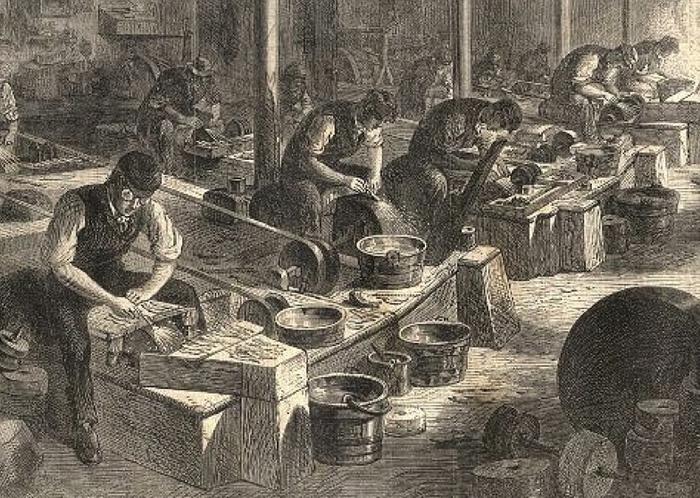
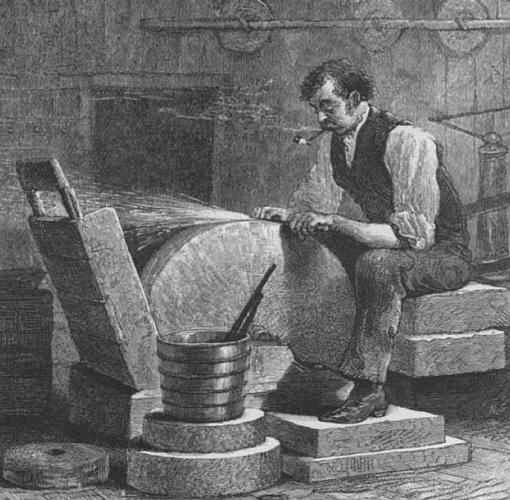
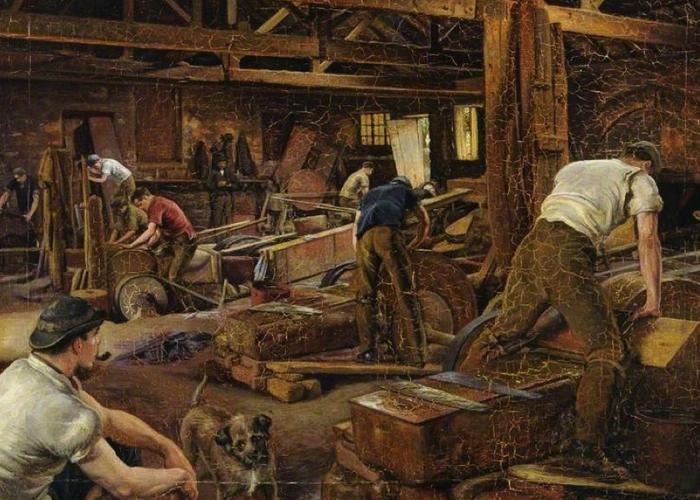
You can clearly see by the sparks which way the wheel is running.
Some pics show how leverage was added - by using a scrap piece of wood to press the steel to the stone. Some even stood over the wheel.
France, Particularly Thiers, seems to have become associated with grinding while laying down, but the practice was carried out in some regions of Sheffield and Solingen, though it did not persist as long as it did in France.
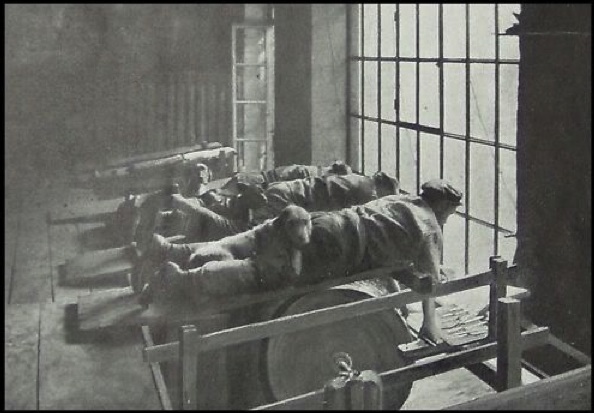
The above is a pic taken in Thiers around 1928, though the practice persisted longer than this. Obviously, the dogs did not add any leverage - the grinder would have to have half his body unsupported for this to come into play. They are there for heat - the bottom of thos boards got cold while splashed with water all day in winter!
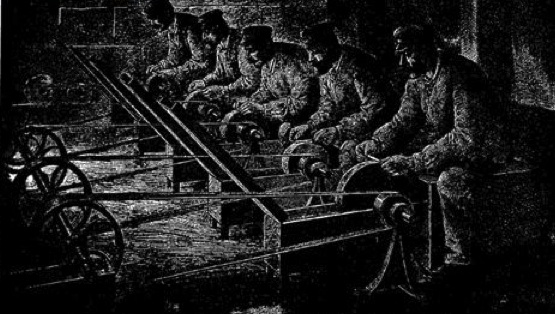
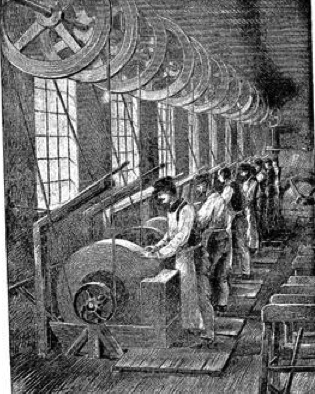
The last two drawings are french, and from an earlier period, and show that not all french grinders lay down while working!
BTW the man with the official title of The Last Razor Grinder in Sheffield was Bill Hukin, who worked at John & William Raggs in Sheffield. He died at the age of 89 in 1999. The man with the official title of Sheffield's Last Jobbing Grinder is Brian Alcock, who is 71 I believe. He holds the title of the last full-time employed grinder, though he is not a razor grinder.
Regards,
NeilLast edited by Neil Miller; 11-15-2014 at 04:11 PM.
-
The Following 4 Users Say Thank You to Neil Miller For This Useful Post:
bluesman7 (11-15-2014), evnpar (11-15-2014), ScottGoodman (11-15-2014), Voidmonster (11-15-2014)
-
11-15-2014, 04:14 PM #20Str8Faced Gent.






- Join Date
- Aug 2013
- Location
- Orangeville, Ontario
- Posts
- 8,463
- Blog Entries
- 1
Thanked: 4207
Great clip. Definitely pre dates whmis and msds's but love to watch the equipment run.
Would be awesome to try your hand at some of those old wheels and belts..
Before the days of guarding and HMIs when things were simpler. Not safer, but definitely simpler.."Depression is just anger,, without the enthusiasm."
Steven Wright
https://mobro.co/michaelbolton65?mc=5


 33Likes
33Likes LinkBack URL
LinkBack URL About LinkBacks
About LinkBacks








 Reply With Quote
Reply With Quote
